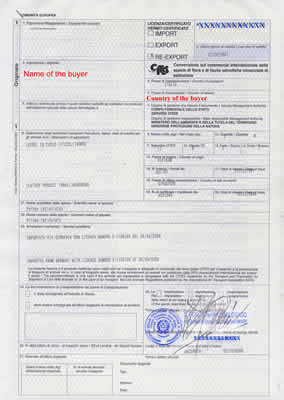What does the word CITES mean?
Why is this document so essential when we export our exotic leather goods to countries outside the European Union?
Why does it take so long to draw up these particular certificates, extending our normal delivery times by several days?
Why do products requiring these documents for their export from the European Union cost more?
Can you do without a CITES certificate?
Here we would like to help you understand the importance of this process and especially why, in some complex situations, the CITES certificate is essential for the successful delivery of the goods, which without a valid certificate would be automatically returned to the sender.
If you prefer to skip the explanations of the terminology of the CITES certificate and just read about why this documentation is so important in the despatch of our products, click here.
Those who are interested in understanding the exact meaning of the terminology connected with the CITES process will find below detailed but simplified explanations of each term used regularly by the CITES department:
What does the word CITES mean? Is it a magic word that protects endangered species of animals and plants or is it just yet another bureacratic obstacle in our way?
CITES - stands for Convention on International Trade in Endangered Species of wild fauna and flora.
The Washington Convention (1973) on International Trade in Endangered Species of wild fauna and flora, more commonly known as CITES, aims to protect endangered species of fauna and flora by regulating and monitoring international trade in them.
169 countries of the world are currently part of CITES.
The CITES Secretariat is administered by UNEP- the United Nations Environment Programme which is based in Geneva.
Protected species covered by CITES are classified into three groups according to the level of threat they face. Import and export of live specimens, of their parts or of products derived from them is either banned (appendix I, with exceptions) or else permitted only with special authorization. In other words:
if you want to trade to or from the EU (importing, exporting or re-exporting) parts of animal species included in the CITES appendices and products made from them (e.g. handbags, wallets, belts, shoes), at the time of import or export you are required to present the original valid CITES certificate (CITES export permit or re-export certificate), issued by the appropriate authority (CITES Management Authority) of the country of origin or provenance. The necessary documents can only be issued upon satisfaction of certain conditions and must then be presented to the customs authorities.
The CITES memebers have established a list of endangered species dividing it into 3 levels of different priorities:
APPENDIX I : (also known as appendix A)
This appendix lists the most endangered animal and plant species of all those listed and protected by the CITES Convention. These species are threatened with extinction and Cites categorically prohibits international trade in them, except when they are being imported for certain non-commercial reasons (article III) , as in the case of scientific research.. In such cases trade is permitted as long as it is authorized by an explicit import permit and export or re-export permit.
APPENDIX II : (also known as appendix B)
This category includes the so-called “monitored species”, that is, species whose trade is monitored and contained. Commercial trade in these species is permitted, but is strictly regulated and every example must be issued with its own Cites certificate in order for a sale to take place. These certificates must show the details of the animal and of its import, the import licence and so on....
APPENDIX III : (also known as appendix C ).
This appendix includes controlled species, where the species is protected within its home state and that state has sought help to control trade in it and limit the decline of the species. These states require the collaboration of other Cites members to prevent unsustainable exploitation and illegal trade in these species. International trade is permitted only on presentation of the relevant permit or certificate.
Both python skin and crocodile skin are included in these appendices; therefore trade in them is carried out subject to the strict rules and procedures enforced by Cites.
Some species of reptiles and snakes are currently in danger of extinction due to the destruction of their natural habitat and due to heavy international trade in them, in many cases through the opportunistic and often illegal sale of their skins. It is possible to contribute to the improvement of this situation by adhering scrupulously to all the regulations concerning trade in protected species.
Leaving aside the terminology now, let's see what it involves for a business to export the derivative, that is, in our particular case, an article made from python, crocodile, or cocco Ligator skin, out of the European Union.
We will analyze the complex business and bureaucratic procedure that must be followed scrupulously in order to consign orders successfully to our clients, without any risk or problems, respecting the trade regulations and endeavouring wherever possible to reduce the amount of time that our client has to wait for his order.
What documents are required by Customs before you can get permission to import or export an article outside the European Union?
Before answering this question we would like to put you in the picture regarding the documents that we must already have and the rules that we must follow scrupulously from the moment we begin production of your exotic leather bag:
- Python and crocodile skin, from its inital import into Italy from its country of origin, must have the appropriate import certificate, which specifies the country that the skin came from, the scientific name of the animal that the skin came from, the licence number relating to its import, the details of the agency that imported it and so on. We would like to emphasise to our clients, that the tanning and coloring of the skins takes place in Italy from start to finish.
- The tannery must make a written declaration, on the relevant document, of the quantity of skins sold to the manufacturers, the numbers of licences under which these skins were imported, the countries of provenance of these exotic skins and so on.....
- Each skin used for the production of an article must be correctly entered in the relevant register of the manufacturer.
What procedures must be followed and conditions met to obtain a re-export certificate once the product has been purchased by a client?
- A Cites certificate must be applied for, to permit re-export of any articles bought by a client, regardless of the quantity of bags or their dimensions. This certificate is temporary, that is, it is issued in the name of the purchaser of the product and is valid only for this one sale. So the buyer would have to apply for a new certificate before re-selling the product for commercial purposes.
To apply for the certificate the following documents must be presented:
- the application form for the certificate, clearly indicating the details of the purchaser (name, surname, address), the details of the vendor, a detailed description of the goods, the provenance of the skin, the import licence, the scientific name of the species, the common name, the appendix that this species is listed in, the source from which this species was obtained (if the animal was raised in captivity or came from its natural habitat),
- the declaration from the tannery enumerating the quantity of skins sold to the manufacturer, the numbers of licences with which these skins were imported, the country of origin of the skins etc....
- the declaration of the manufacturer of the number of skins used in the production of the product in question and the numbers of licences with which these skins were imported into Italy;
- the import licences relating to the skins used in the production of the article;
- receipt of payment of the government tax.
Once the Cites certificate has been issued (this takes several days), all the products, as well as the documents issued and the invoice must be presented to the relevant supervisary authorities (in Italy this function is performed by the administrative branch of the Forestry Commission) for checking. After careful monitoring by the agent of the authorities in charge of this task, the original Cites certificate will be issued, with the customs stamp and the DG2 form, which authenticates and guarantees that the details entered on the documents correspond with the products themselves.
This form will be required for the import of the products into the country where the goods are being delivered.
| As you can see, the procedure we have to follow to despatch any of our products, made from the skins of species that are included in the above Cites categories, is quite complicated and demanding, as every step must be carried out meticulously, following the letter of the law and abiding by its restrictions.
It is important to understand that this procedure ABSOLUTELY MUST BE CARRIED OUT regardless of the quantity of articles purchased by the client, of the skins used or their volume.
Even if there is just one pendant or a fine binding made of python or crocodile leather, in the lining of the handbag., the same procedure absolutely must be applied, with the same meticulous attention as for a large consignment of articles made entirely of python or crocodile.
Because of this, we advise our clients to purchase at least two articles together (two belts or a belt and a bag, or even two bags) so as to spread the cost of issuing the Cites certificate, (the Cites certificate costs the same to issue for one item as for two or twenty, and you'll be getting more goods out of it).
In summary of all we have said above, we can conclude that:
- trade in our products is carried out according to the rigorous criteria, which regulate trade in protected species, and by means of obtaining a Cites certificate, which permits goods to pass smoothly through customs, without the risk of being sent back or prolonging the delivery time, even though the preparation of these very important documents takes several days.
|
The Cites certificate cannot be issued by the local authorities where the business is based, but only in the departments of approved Cites authorities that are specialized in drawing up these documents. In most cases these authorities are located at a considerable distance from the town where the business is based.




